Groote Eylandt’s deadly inheritance
In this Australian island paradise, it’s the humans most at risk of dying out.
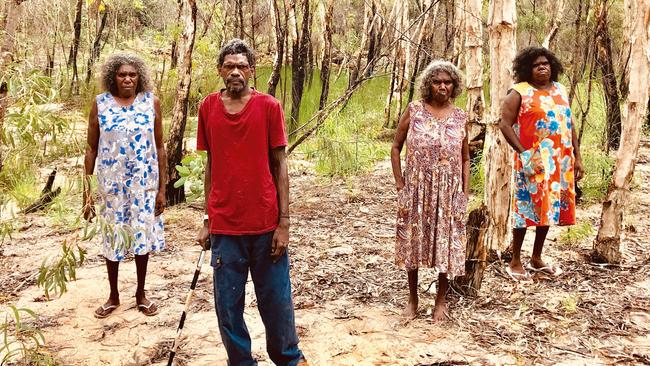
The unbroken ring of ochre-coloured paint around the outside of the house says there’s been a death in this street and we must turn the car around. Steve “Bakala” Wurramara raises a weak and shaking right hand from the front passenger seat of the rattling LandCruiser, asks his driver to reverse and take a right down a side street. A right, then a left and this street, too, is blocked by three red traffic cones because a family is in mourning for another lost loved one on Groote Eylandt, the fourth largest island in Australia, off the remote eastern coast of Arnhem Land about 630km from Darwin. Reverse, take another side street, across a wet dirt track and into a third blocked street in mourning, this one lined with a barrier of old car tyres. “Turn…” Bakala says, and his second word takes concentration, must be willed into speech: “… around.”
Some 12 threatened animal species thrive here on Groote. Creatures long endangered on the mainland such as the northern hopping mouse, the brush-tailed rabbit rat and the northern quoll frolic here in relative bliss amid 900 plant species towering over freshwater creeks and bordering gold beaches. The warm Gulf of Carpentaria waters are alive with nesting marine turtles, tropical seabirds, mud crabs, whales and the finest eating fish in all the world. In this beautiful and peculiar archipelago, it’s the humans who appear most at risk of dying out.
The car pulls off a long dirt road, switching to low gear to traverse a rough path of ancient boulders and erosion gullies towards a deep bush waterhole the locals call Top Crossing. There are sacred cave paintings beyond the thick swamp grasses and paperbarks that speak of the 8000 years that some 14 clans within the Anindilyakwa people have co-written the story of this island.
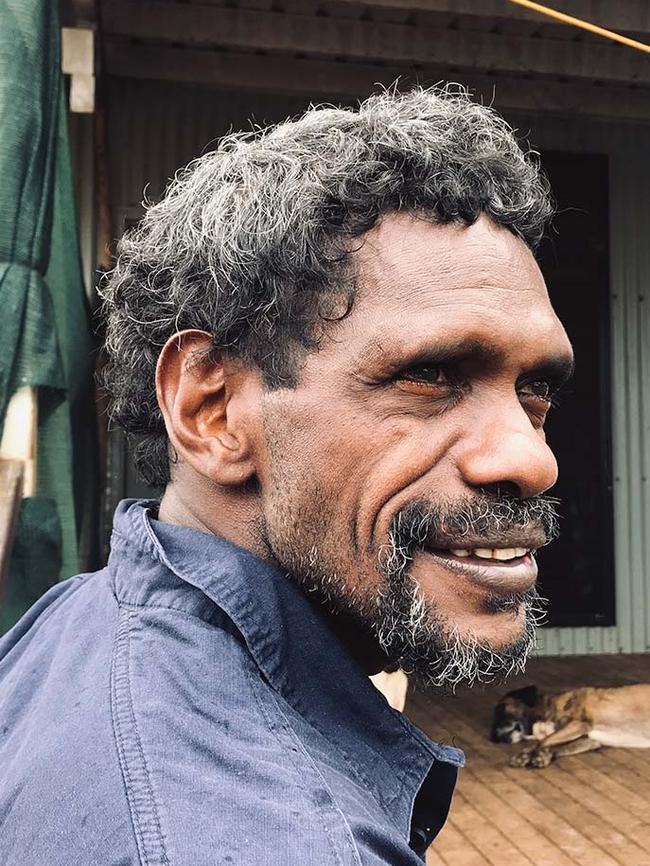
Bakala — handsome and lean, mid-40s — grips a safety hold on the car’s exterior as he tentatively plants a foot on the sandy and uneven ground. This is where he believes he will find the cure to his disease. A walking stick takes his weight on his right side and he balances his left hand on my shoulder as he “wobble walks” into the place of the spirits.
The wobble walk was an early sign of the Groote Eylandt “sickness” for Bakala. Police officers have been known to mistake the walk for public drunkenness. It wasn’t so long ago that Groote locals with the sickness were mistakenly thrown into paddy wagons, too panicked to slow down and concentrate on their words so they could explain themselves. The reason for their staggering, lurching gait is Machado-Joseph Disease (MJD), a genetic neurodegenerative condition so mysterious and incurable that many of the island’s 1100 traditional owners remain convinced it’s a black magic curse.
With a series of unsure steps, Bakala moves deeper into the bush. Here, he speaks to the trees and the grasses and the water flowing over rocks. There are stories shared across the island about Bakala’s knowledge of wild bush medicine, his knowledge of sorcery. People have told me he once swallowed the venom of a deadly snake in an attempt to kill the sickness. His people honour him as the custodian of certain sacred shaman objects, some of which were passed down to him by his grandmother and father, who themselves had magic knowledge. He talks to the air. He talks to the wind. He talks to his ancestors in his Anindilyakwa language. And he wobble walks back to the passenger seat of the LandCruiser.
“What did you say to them?” I ask
He smiles.
“Help me,” he says.
On the tiled floor of a small office opposite the Groote Eylandt supermarket and fish and chip and fried chicken drumstick shop, Libby Massey spreads a story of tragedy and death from one side of the room to the other. She’s studying 20 A4 papers taped together to form what is titled “The Groote Eylandt Pedigree”. It’s a family tree of blood-tied locals, all members of a single descent line. “If they have a red dot beside their name they’ve had MJD and they have passed away,” says Libby, the MJD Foundation’s director of research and education. The chart is covered with red dots.
She runs a forefinger over the family tree. “So it’s going down the generations,” she says, pointing at a name. “That’s the first old man that we know for sure had it, and these are his children, and these are his children’s children. Bakala is the grandson of that old man. Bakala’s mum had it. He has it. His brother has it. His sister has already died of MJD.” She studies the tree. “We now know who has developed the disease and passed away, and we know which of their children we’re either watching closely or who have already shown signs of the disease.”
Endless names of children with symptoms or considered high risk. Ages beside their names: 12, 15, 10, 16. Some of these kids are playing handball outside the fish and chip shop as we speak. Others are tossing handlines baited with beach worms off the Umbakumba jetty on the other side of the island. Herein lies one of the many moral dilemmas facing the Groote community: at what age should a child be told they carry the MJD gene? At what age should they be told their mum or dad passed them a ticking time-bomb at birth?
“I see them come into the office with their parents and I look at them and I think, ‘What’s gonna happen to you? What’s your future?’ You’re worrying about them and they’re smiling back at you because they’re the happiest kids on Earth,” Libby says. She paints one potential future for them. “If you know about motor neuron disease you’ll have a picture of what happens to people, but it’s a completely different disease in the way it works,” she says. “It starts with a wobble and you end up in a wheelchair unable to move and talk.” Thoughts and feelings remain alert and functioning, locked inside a shell of permanent disability. “Progressively, the body shuts down over a period of 20 years and you will eventually die.”
There are pockets of people with MJD across Australia and the world. There are mutations of the disease originating in Brazil, Japan, Germany, France and the Azores, the ancestral home of family patriarchs William Machado and Antone Joseph, who were first identified with the condition in 1972. Libby refers to a PowerPoint slide. “MJD Prevalence — updated Jan 2019”. A map of Australia highlighting MJD clusters across the country. Five people have tested positive in Central Australia. Five in North Queensland. One case in South Australia. The highest concentration of MJD in the world is here on Groote Eylandt, where an estimated 186 members of the 1100-strong indigenous population have parents or grandparents who carry a particularly intense Asian MJD mutation that may trace back centuries to direct contact with foreign fishermen and traders. “It’s an older strain and prone to anticipation, which means that every generation gets it younger and gets it worse, really,” Libby says. “Because you’re getting it younger, your trajectory to illness is quicker.”
And the numbers will only increase. “It has a 50 per cent chance of spreading with every conception,” Libby says. “Every time someone with MJD has a child, that risk is there. The numbers will continue to grow, there’s no two ways about it.”
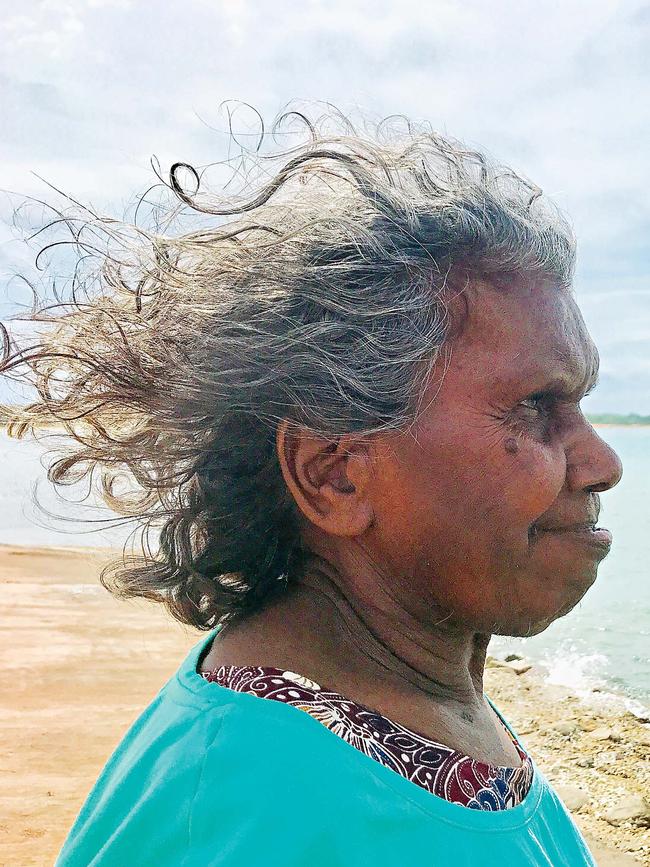
An indigenous woman with curling grey hair shuffles into the MJD Foundation’s therapy space, rests on a two-seat couch beside a large box that’s just arrived carrying a new wheelchair for another MJD patient. This is Gayangwa Lalara, mid-70s, island matriarch. In the dark genetic MJD lottery she lucked out. She doesn’t carry the gene, but she has lost six siblings to the disease and countless lifelong friends. Now the third and fourth generations of her family are facing MJD. She lost her 21-year-old niece to it in 2014. Her remaining years on Groote will be spent running a small blue house, a stone’s throw from this office, filled with orphaned nieces, nephews and grandchildren all identified as carrying the gene. Her adult life has been a series of sunshine days within the prism of a permanent state of mourning.
“I grew up here,” Gayangwa says. “We were out in the bush, a very big family. There was nobody here to help us then, no clinic.” She remembers loved ones dying a half-century ago from MJD. She remembers the pain and confusion and brutality in those deaths.
“People died really horrible deaths only 10 years ago,” Libby says. “People died of things like bowel obstructions. People would be evacuated from here because it wasn’t well understood that you would lose your bowel motility and that’s one of the common causes of death, or aspiration pneumonias where you can’t swallow, or they’d get chest infections and infected bed sores and pressure sores, all of those basic care things.”
“People never understood,” Gayangwa says. “There was no cure. And I didn’t really understand that it was a genetic thing. We thought it might be from the manganese.” Manganese has been mined on the island for more than half a century. Indigenous mining royalties have enabled the MJD Foundation to exist since 2008 when it was co-founded by Libby and her long-time friend, foundation CEO Nadia Lindop, a former business consultant. “But then we found out it’s inside us,” Gayangwa continues. “They used to say it’s a curse but, really, it was inside us all along.”
Her father’s name is in the top line of Libby’s Groote Eylandt Pedigree chart. From this name spreads a family tree of locals living with the disease. A handful of them now file in to the foundation headquarters. “My father was a strong man,” Gayangwa says. “But everybody gets weaker. My brothers were strong and fit but they got weaker. I used to get sad. And I got ashamed about mentioning this disease. I didn’t talk about it to people. It was too hard to talk about it. Too shameful.”
It was Gayangwa who taught Libby both the Anindilyakwa language and English in the old timber church a few streets from here, where she worked as a preschool teacher. Libby came to Groote as a small girl in 1970. Her parents, Bryan and Kathy, were missionaries who became so intimately tied to the Anindilyakwa people over four decades of community work that Gayangwa considers them genuine members of the family. For much of Libby’s pre-teens, she considered herself as Aboriginal as anyone else at school. Locals call her “Lamington girl” and she doesn’t mind at all. She’s always been a lot of black and a lot of white, too.
Bryan Massey spent the first 25 years of his time here as a mechanic. He didn’t force the gospel on anyone. His approach was beautifully simple: let me fix your car and if you’ve got something else you want to get off your chest, I’m all ears. He never really knew why he came to Groote Eylandt in the first place — God never fully shared that answer — until he returned in retirement and walked into this therapy space. He saw countless locals whom he loved as family enjoying real funded care, real funded change. He turned to his daughter with tears in his eyes. “I know why we came,” he said.
By the rear doors of the space, Jacob McCue, the foundation’s manager of community services, helps several clients out of a vehicle. People come from across the island to access everything from genetic education services, meals and advocacy to housing assistance, emergency medical advice and the use of exercise equipment — good health, fitness and regular exercise is, so far, the best known way to delay MJD’s effects.
Foundation staffers must convey the importance of halting the spread of MJD without alienating clients, many of whom are bound to strict cultural laws and belief systems that exist in opposition to the complex scientific onslaught of the disease.
In a corner of the room, a new client watches a video in which a carer is talking in her native Anindilyakwa language: Watching my family with MJD, I have seen that they have problems with walking, talking, eating and swallowing, eyesight, sleeping and going to the toilet. But I noticed that their brain stays smart. I found out that this is because the messages or signals that come from the movement part at the bottom of the brain get weaker and weaker until signals are nearly finished. MJD happens because inside our bodies there is a change to something very tiny that doctors call ‘genes’. We can call the genes ‘stories’ or ‘laws’ inside us. They come from our mother or our father and they tell our bodies what to do. These genes came to them from their parents, their grandmothers and grandfathers.
“Belief systems are very, very different from family to family,” Libby says. “Some families have clear understandings of the genetics side of it. Some families have more traditional orientation and find the story of how it happens in medical terms very confronting because it’s different to what they have been taught.”
Some Groote residents believe that all family information is passed down only from the father. “If you’re a man and you’ve inherited this disease from your mum and some little white girl like me comes in and says, ‘You say your story comes from your dad, but you actually inherited this disease from your mum’, then what am I saying to that man? Is it saying, ‘I don’t believe what is true for you?’ So then we have to convey a narrative that is respectful and some of the things we talk about are, ‘Well, this is a disrespectful disease, it’s not a cultural disease. It’s come from somewhere else and it’s not obeying the rules of your people. Yes, you do get your information from your dad but this disease has done something cheeky, it’s doing the wrong thing’.”
Groote Eylandt men often lay the blame of misfortune on external forces. There are stories about a warrior ancestor — the first to be cursed with MJD — who killed a dugong and cut it up in spiritually damning ways and suffered the consequences of his actions. Dark curse stories about killings and comeuppance.
“You still hear that word, ‘curse’, everywhere,” Libby says. When she was growing up, “when somebody died here it was always, ‘Who cursed him? Why and how was he cursed?’” It’s a culturally understandable way to comprehend the incomprehensible. “But you know what I say to our workers sometimes? If it looks like a curse, smells like a curse, who am I to say it’s not a curse? Because it sure feels like one.”
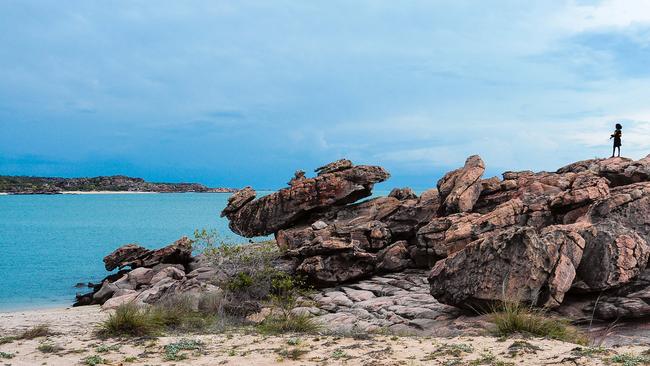
Sisters Melinda and Joyce Lalara are looking over a collection of photographs the foundation carers have stuck to the therapy space walls. The images are from days “on country” when Jacob has taken them fishing and picnicking at favourite island spots their MJD usually prevents them from accessing. The sisters can only move with wheelchairs and walkers these days. Memories of mobility bring the melancholy. “I hate...” Melinda strains to say, “this... dis... ease.”
Her father had the disease and she was his chief carer. She started showing symptoms of MJD at 21 when her father’s condition was at its most debilitating. Every time her father stumbled, every bedsore she cleaned and bandaged for him was a reminder of her future. For no particular reason Melinda smiles, a big wide grin that lights up this room. It’s just something she does.
“I’m now 40… something,” she says proudly. She looks 30-something at most. “Black don’t crack!” hollers another MJD client from across the room, and the place echoes with laughter.
Melinda takes time to consider a question I’ve put to her about the thing she misses most about full mobility. She exhales loudly, nodding her head, strains to piece the sentence together: “I... hate... this... because... I... want... to... dance.”
Gayangwa lays a gentle hand on Melinda’s forearm. She does this with everyone, even strangers from far away. Some days Libby approaches Gayangwa with news that another local teen has tested positive with the MJD gene. “When do we tell them?” Libby asks. And Gayangwa drops that gentle hand on her forearm and says, “Not yet, Libby. Just wait. Just wait.”
She wants those kids to live as long as they can without the burden of this disease. She wants to let them live without the curse. She’s holding the pain off for herself, too. All those questions her loved ones keep asking her: “What’s happening to me? Why can’t I walk properly? Why did this happen to me?” Then time steals their walk, their independence and, finally, their language. The last question Gayangwa hears before they go for good is always the same. When will they find the cure?
This is how Bakala picks up his coffee mug. Hetells himself, first, that he wants to pick up his coffee mug. Then he tells his right hand to move and he looks at it when he does this, and his right hand rises like a helicopter taking off and rushes in one jerking motion toward the mug and stops at the handle. Then he wills his fingers to grip and they reluctantly move into action, finger by finger. He brings the mug slowly to his mouth and then he brings his lips slowly to it, and he sips.
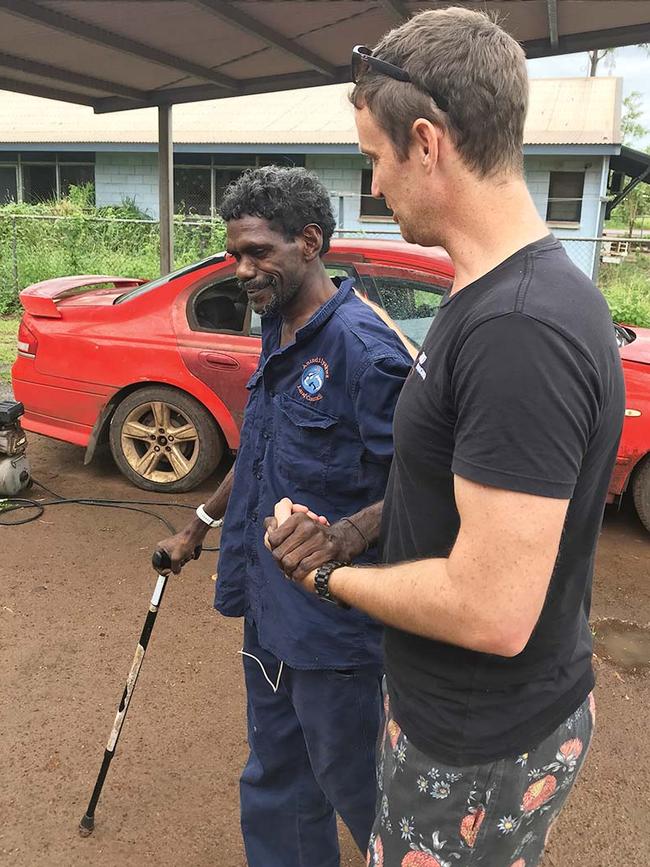
Bakala is at work now in the Anindilyakwa Land Council’s media office, where he makes short films about his beloved island. He’s building a history of his people, and the history of MJD in the Northern Territory is starting to be told within it. At a desktop computer he plays an old recording he’s found of Melinda and Joyce’s father singing a sacred songline.
The disease steals the sound of the song, he explains, but it can’t steal the song. The songs are everywhere. In the trees, in the grass, in the rocks, in the ground. And the song is like the cure. “I feel it’s there,” he says. “It’s all one. All one.” Love and loss. Diseases and cures. All one. Bakala’s elusive cure will come from the same place the disease came from. Life.
The MJD carers believe Bakala should be in a wheelchair. He believes the wheelchair slows him down — keeps him from going where he needs to go for his people — so he wobbles along precariously with a walking stick. For as long as he’s able, Bakala will venture into the wild to collect bush foods and venoms and plant toxins and random insects that he believes may hold the key to a cure. Sometimes he falls flat on his face; falls hard onto rocks that leave bruises across his body. But he pulls himself up and keeps on collecting scientific samples that he sends off to the bright lights and bright minds of Sydney.
“I’m always impressed with how well Bakala, and everybody on Groote, understands what we’re doing,” says Dr Angela Laird, a key member of the groundbreaking team at Macquarie University that has created the first transgenic model of MJD inside the endlessly useful zebrafish. “I think it’s because this work means so much to them.”
Bakala recently travelled to Sydney to see Laird’s lab work up close. He learnt all about how the humble zebrafish — a favourite of aquarium owners across the world — has brought his family closer than ever before to that elusive cure.
“Zebrafish are suitable for investigating potential treatments for MJD because we can perform the testing more rapidly than in other more traditional lab animal models, because a female zebrafish has hundreds of offspring each week,” Laird says. “They’re transparent during development, allowing us to monitor their neurons and, importantly, they can be treated simply by adding substances directly to the water they live in.
“We can genetically manipulate them to carry the human gene that we know causes the disease, and we can also genetically manipulate them to have coloured neurons. That means we can see under the microscope any changes to the neurons caused by the presence of the mutated gene. We are now working towards testing different drugs that might help with clearing the toxic protein that we know causes the disease.”
Her friends on Groote always have a hundred questions, and then just one: How long? “We would never jump straight from a zebrafish finding to treating a patient,” she says. “We’re using the zebrafish to try to clarify which options are worth pursuing further. I would expect at least another 10 years before things were possible for use in humans.”
It’s a process of scientific elimination and Bakala’s instinctive treasure hunts through deep Groote wilderness have become a serious part of that science. Laird has formed a collaboration with researchers at the Griffith Institute for Drug Discovery at Griffith University in Brisbane, who have extracted and purified natural products from Australian flora and fauna to create “NatureBank”, a vast biodiscovery library of more than 90,000 test samples derived from native plants, fungi and marine invertebrates that can be used for screening against any disease target.
“We’re setting up a deeper study to be able to test the things that are linked with the traditional medicines that Bakala and other community members are interested in having tested,” Laird says. “The patients are training us in treatments they know more about than we do. We don’t know where it will go but a combination of science and serendipity may just take us in the right direction.”
Bakala sees Laird’s work as her own kind of sorcery. Her own kind of magic. “Help me,” he says to his ancestors when he walks into that wild and bountiful Groote scrub. Sometimes he asks them to help Laird, too.
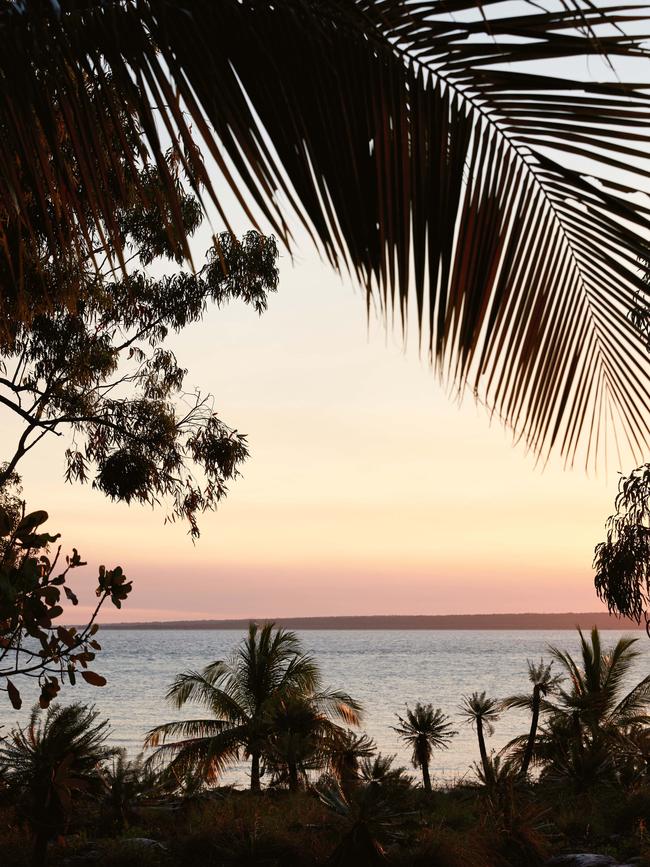
Silence in the Groote Eylandt cemetery. Gayangwa and Libby have come to pay their respects to loved ones lost to MJD. There’s no particular grave they want to visit. They take them all in. Old and new stone epitaphs for loved ones resting beneath red dirt mounds. There’s more than one funeral a month on Groote and the island stops for each one. Workers go home. Shops close. Mourning is given the respect it deserves.
“It’s going to get a lot harder,” Libby says. “We have people here getting really sick. We are about to go through a phase of really watching people lose their independence totally, and watching family members cope with that.” She can’t bring herself to say what happens after that.
Gayangwa is staring at the gravestone of a nephew who died of MJD in his teens. “I used to get angry,” she says. “I lost my sisters and I lost my brothers and I’d get angry and I would think, ‘It’s not my culture, it wasn’t my culture that came and introduced this to the community. It’s not from Groote Eylandt’. And I used to get angry at my parents but I knew it wasn’t their fault. And I used to get angry at myself. ‘Why me? Why didn’t I get it?’ But then I think I’m here to tell people it’s happening. It’s been happening in the past and it’s happening now. And I don’t have that anger in me now. It’s gone out of me.”
She ambles on, deep into a cemetery that blends into native trees and wild bush plants. “When I come back here my memories come back,” she says. “I remember them all, the times when they were alive.”
Not just alive, but strong. She remembers them walking and talking freely, fully mobile. “We’re sharing together, we’re laughing,” she says. She waves a fly from her face, looks deeper into the scrub. “We are a family.”


To join the conversation, please log in. Don't have an account? Register
Join the conversation, you are commenting as Logout